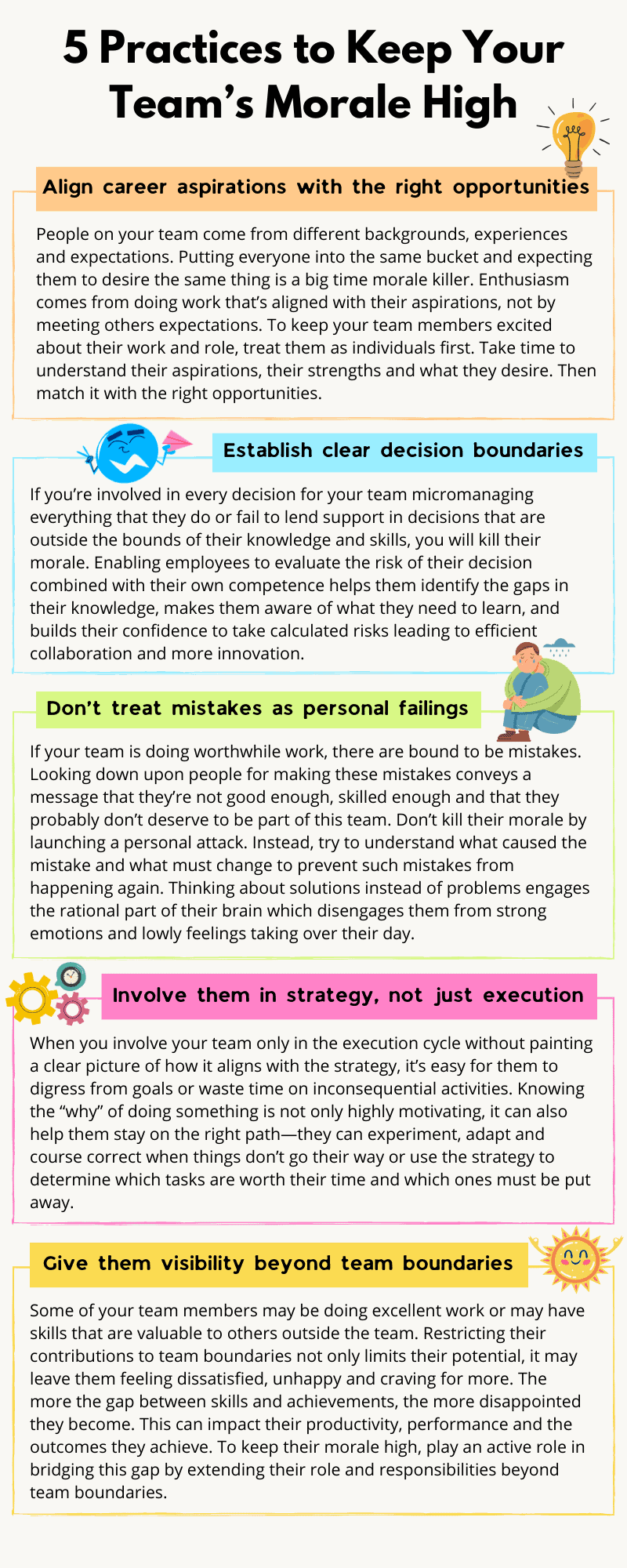How to Keep Your Team’s Morale High

A team’s performance isn’t solely based on the talent of its members. Multiple other factors—motivation, desire and confidence—play a role in it.
When a team’s morale is down, all their knowledge, experience and skills goes to waste.
Without motivation, even simple tasks turn into a drag.
Without desire, the drive to achieve excellence takes a backseat.
Without confidence, feelings of self-doubt, unworthiness and inadequacy creep into how they think, decide and act which makes them play safe and give up great opportunities that are even a little bit risky.
High morale in a team turns obstacles into opportunities, gives them courage to stay resilient in the face of challenges and inspires them to learn, grow and succeed. It makes magic possible by turning impossibilities into possibilities.
While motivation fires up our interest and willingness to run the race, encouragement helps get us across the finish line.
— Cathy Burnham Martin, Encouragement
Keeping your team’s spirits high takes work, but it will be one of the best investments of your time and energy. Done right, it will be your biggest ROI.
Many things can sap your team’s morale at work. Instead of blaming your team for not achieving the targets or berating them for wasting their potential, work on fixing their morale and everything else will fall into place.
Here are the five practices to create a highly enthusiastic and unstoppable team:
Align career aspirations with the right opportunities
You can’t inspire and lead people without earning their attention. You achieve that in a counter-intuitive way – by paying close attention to what interests them.
— Phil Dourado, The 60 Second Leader
People on your team come from different backgrounds, experiences and expectations.
Some might be in a hurry to climb the career ladder while others might be happy to stay where they are.
Some may want to take on a management role while others might want to contribute individually.
Some may like building deep technical products while others may enjoy more problem solving challenges.
Putting everyone into the same bucket and expecting them to desire the same thing is a big time morale killer. Enthusiasm comes from doing work that’s aligned with their aspirations, not by meeting others expectations.
To keep your team members excited about their work and role, treat them as individuals first. Take time to understand their aspirations, their strengths and what they desire. Then match it with the right opportunities.
Aligning their career goals with the goals of the organization will be a win-win for both the organization and your team.
Establish clear decision boundaries
If you give employees more freedom instead of developing processes to prevent them from exercising their own judgment, they will make better decisions and it’s easier to hold them accountable.
— Reed Hastings, No Rules Rules
There are two types of decisions—ones your team can make independently and the others that require your support.
If you’re involved in every decision for your team micromanaging everything that they do or fail to lend support in decisions that are outside the bounds of their knowledge and skills, you will kill their morale.
Not being empowered to make their own decisions keeps them dependent and lowers their confidence to handle decision-making.
Not providing adequate support for decisions they can’t make on their own leads to poor decisions which upsets and demotivates them from building these skills.
To boost your team’s confidence, establish clear decision boundaries. Enabling employees to evaluate the risk of their decision combined with their own competence helps them identify the gaps in their knowledge, makes them aware of what they need to learn, and builds their confidence to take calculated risks leading to efficient collaboration and more innovation.
Autonomy that comes with decision making leads to engagement and engagement leads to fulfillment and satisfaction.
Don’t treat mistakes as personal failings
The only real mistake is the one from which we learn nothing.
— Henry Ford, My Life and Work
If your team is doing worthwhile work, there are bound to be mistakes. Looking down upon people for making these mistakes conveys a message that they’re not good enough, skilled enough and that they probably don’t deserve to be part of this team.
Berating your team for making mistakes shakes their confidence and leaves them with feelings of unworthiness and self-doubt.
Don’t kill their morale by launching a personal attack. Instead, try to understand what caused the mistake and what must change to prevent such mistakes from happening again.
Thinking about solutions instead of problems engages the rational part of their brain which disengages them from strong emotions and lowly feelings taking over their day.
Learning to handle mistakes well keeps them moving forward even when things don’t work out as expected. They don’t wallow in self-pity or waste time replaying the mistake in their head.
Involve them in strategy, not just execution
If we want to feel an undying passion for our work, if we want to feel we are contributing to something bigger than ourselves, we all need to know our WHY.
— Simon Sinek, Find Your Why
When you involve your team only in the execution cycle without painting a clear picture of how it aligns with the strategy, it’s easy for them to digress from goals or waste time on inconsequential activities.
Not having a purpose and a clear sense of direction can also bring down their morale—it’s hard to keep going when there is no sign of hope or progress in the future.
Knowing the “why” of doing something is not only highly motivating, it can also help them stay on the right path—they can experiment, adapt and course correct when things don’t go their way or use the strategy to determine which tasks are worth their time and which ones must be put away.
Don’t turn your team into blind executioners. Give them the context, clarity and the information needed to understand how their goals connect to the larger interest of the organization. Do this and your team will surprise you with their results.
Give them visibility beyond team boundaries
Knowledge is power, and you should give power to those who have the knowledge.
— Nicole Forsgren, Accelerate
Some of your team members may be doing excellent work or may have skills that are valuable to others outside the team. Restricting their contributions to team boundaries not only limits their potential, it may leave them feeling dissatisfied, unhappy and craving for more.
The more the gap between skills and achievements, the more disappointed they become. This can impact their productivity, performance and the outcomes they achieve.
To keep their morale high, play an active role in bridging this gap by extending their role and responsibilities beyond team boundaries.
Do they have great collaboration skills? Give them an opportunity to lead a project that requires collaboration across multiple cross functional teams.
Did they design a great tech product? Have them give a tech talk to the entire team.
Are they great at coding? Have them design coding challenges for the next hackathon.
Giving visibility beyond the team puts a spotlight on them which helps them shine and succeed.
Your employees are your greatest asset. Invest in them and enable them to do their best work by understanding what they desire, clarifying decision boundaries, treating mistakes as learning opportunities, aligning strategy with execution and giving visibility beyond team boundaries.
These practices will keep their morale high, and with a high morale they’ll be willing to go the extra mile to make the team and the organization successful.
Summary
- If your team isn’t meeting expectations or not performing as well as they should, pay attention to their morale. Low team morale saps them of the enthusiasm and confidence required to thrive and succeed at work.
- Giving opportunities to your team members without understanding their aspirations leads to suboptimal allocation of work and responsibilities. Your team members have different expectations when it comes to their career and what they desire. Understand that first and then match it with the right opportunities.
- When your team is not empowered to make their own decisions, it makes them feel helpless, hopeless, incompetent and powerless. These negative feelings creep into how they communicate, collaborate and get work done. Build their confidence by enabling them to separate decisions they can make independently from the ones that require got support.
- Assigning negative labels to people when they make a mistake leads to feelings of low self-worth and self-doubt which erodes their confidence and self-esteem. Instead of treating mistakes as a personal flaw, engage them in problem solving.
- If people on your team only know what to do, without understanding why, they may feel lost when faced with a setback or waste time on inconsequential activities. Keep them on track by helping them connect dots from strategy to execution.
- Talented team members who are restricted to team boundaries are highly susceptible to feelings of dissatisfaction, disappointment and being let down. Making their work visible and giving them opportunities to contribute beyond team boundaries is a great way to bring a sense of satisfaction and fulfillment into their jobs.





























